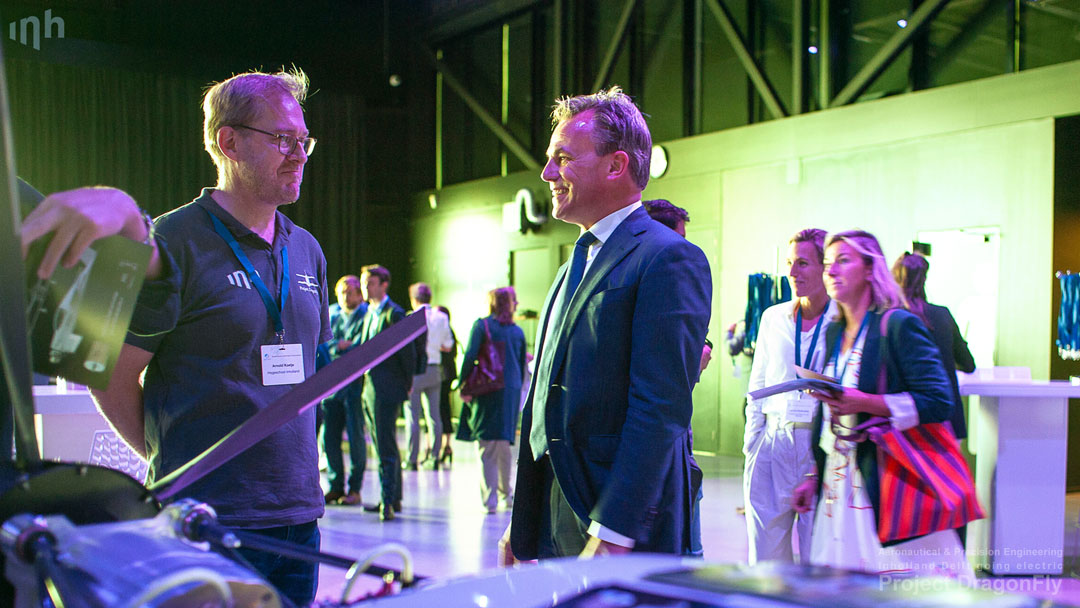Inholland Students and Faculty Showcase Technological Innovations

The aviation industry is on the verge of significant changes, which are much needed. Aviation must become more sustainable and less polluting. At the Sustainable Aviation Event, the Dutch aviation industry gathered for inspiration, knowledge exchange, and networking. Students, researchers, and instructors from the Aviation Technology program at Inholland University in Delft were also present. In particular, the Dragonfly, an electric aircraft built by students, attracted a lot of attention and piqued curiosity.
Human capital
According to Inholland program manager Arnold Koetje, the Inholland University undoubtedly plays a role in sustainable innovation: “We are one of the few entities that specifically educates engineers to work on this. With this I mean, particularly the transition to electric flight and the creation or modification of designs to make this possible. This is evident in the development of the electric Dragonfly, the first aircraft in the Netherlands to be converted into an emission-free lightweight aircraft. We are actively working on certification and the final modifications, with hopes that the Dragonfly can make its first flight by the end of this year. Our students are driving and supporting this project, providing them with a strong foundation in electric and sustainable aviation. We see this as our role: ensuring that future ‘Human Capital’ is equipped to make this necessary transition.”
 Lodewijk Asscher & Antoine Gerritse
Lodewijk Asscher & Antoine Gerritse‘It Can Only Be Done Together’
The event also highlighted that electric flight alone is not the only solution. The event was organized by the Sustainable Aviation Table, a collaborative effort aimed at promoting sustainability and innovation in the aviation industry. The chair of this “table” is former Minister Lodewijk Asscher, who was also one of the speakers. Lodewijk Asscher emphasized the importance of finding a balance between people’s travel needs and the responsibility to make the world smaller and more sustainable. This requires both small changes and savings, as well as significant technological innovations. Asscher said, “Many good things are already happening, but we need to step up our efforts. I will be satisfied if, by the end of the day, we leave with the hope that we can change this together. Everyone needs to be committed because it can only be done together.”
Sustainable Reconstruction of Aviation
Speaker Mark Harbers, the outgoing Minister of Infrastructure and Water Management, made a “strong call for cooperation.” He referred to the historical significance of the event’s venue, International Airport Teuge. “On August 2, 1945, Princess Juliana and her daughters set foot on Dutch soil here for the first time after World War II. A symbolic moment that gave hope and marked the beginning of reconstruction. Perhaps this event is the starting point for the ‘reconstruction’ of Dutch aviation.” Harbers cited examples from the inspirational market at the event, such as the development of (hydrogen) electric flying, the use of drones, and the application of lighter materials like titanium, composites, and magnesium. “The Netherlands has a tradition of pioneering and pushing boundaries, as Fokker and Plesman did in the past. Let’s do that now to make aviation sustainable together.”
 Students with electric Dragonfly
Students with electric Dragonfly
The third speaker was Gerrit Hiemstra, a meteorologist, entrepreneur, and best known as a weather presenter on the NOS Journaal. He illustrated, using clear (weather) graphs, how much the climate has already changed due to human actions. This emphasized the need for action, for which he provided specific guidance, both in general and for the aviation sector. He did not shy away from addressing the “elephants in the room” either: “Less flying! Every kilogram of fossil fuel contributes. The problem is fossil fuels, so the solution is to stop using them.” The choice he presented to “the industry” was: “Do you want to be like the tobacco industry that continues in the same way for as long as possible, or like Tesla, leading in sustainable innovation?”
Let Young People (Participate in) Decision-Making
Hiemstra concluded his speech with a call to always consider the next generation. “They will be sitting in your seats in 10, 20 years. The decisions we make now are for the new generation.” In the closing panel discussion (with Asscher, Hedwig Sietsma, director of climate policy at KLM, and Marjolein Demmers, director of Nature & Environment), there was a strong focus on the new generation, especially the students from TU Delft and Inholland University in Delft who were present. In the conversation with Inholland students, Hiemstra took it a step further: “Education is our future. Involve young people, students, in decision-making now. In many cases, it’s the 40- and 50-year-olds who make the decisions, while sustainability is a natural starting point for many students. So, don’t just ask young people for their opinions, but let them genuinely participate in decision-making.”
 Lodewijk Asscher & Brecht van Hulten
Lodewijk Asscher & Brecht van Hulten


